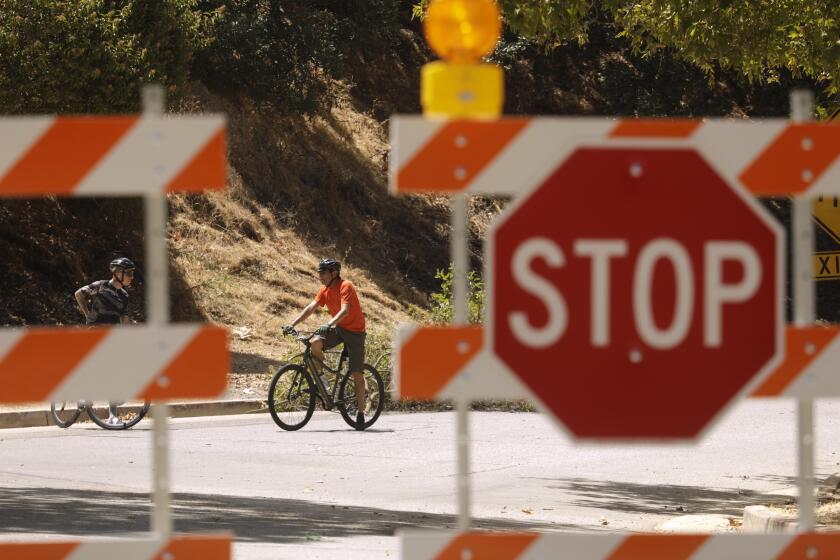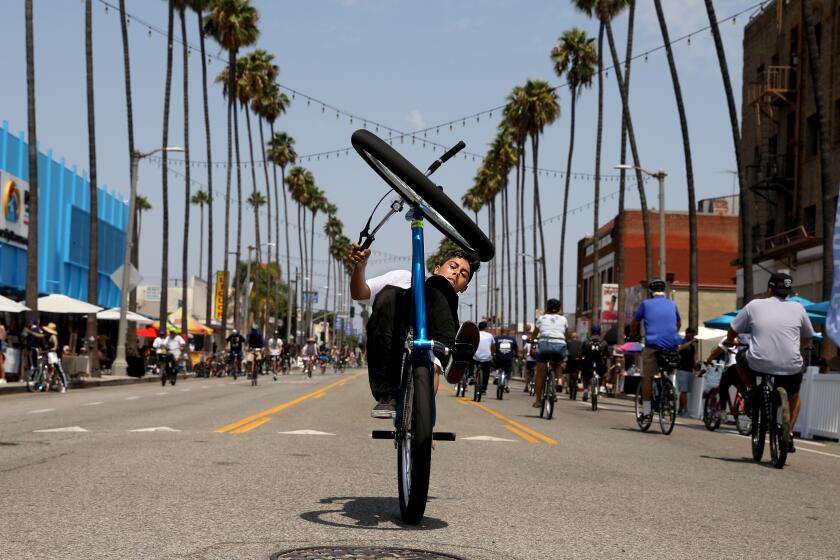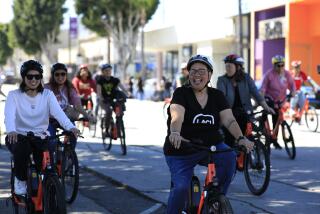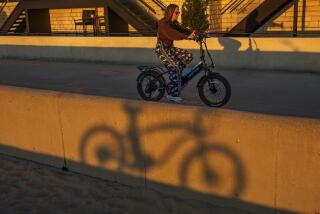E-bikes aren’t just faster, they’re a different ride. Here are safety tips
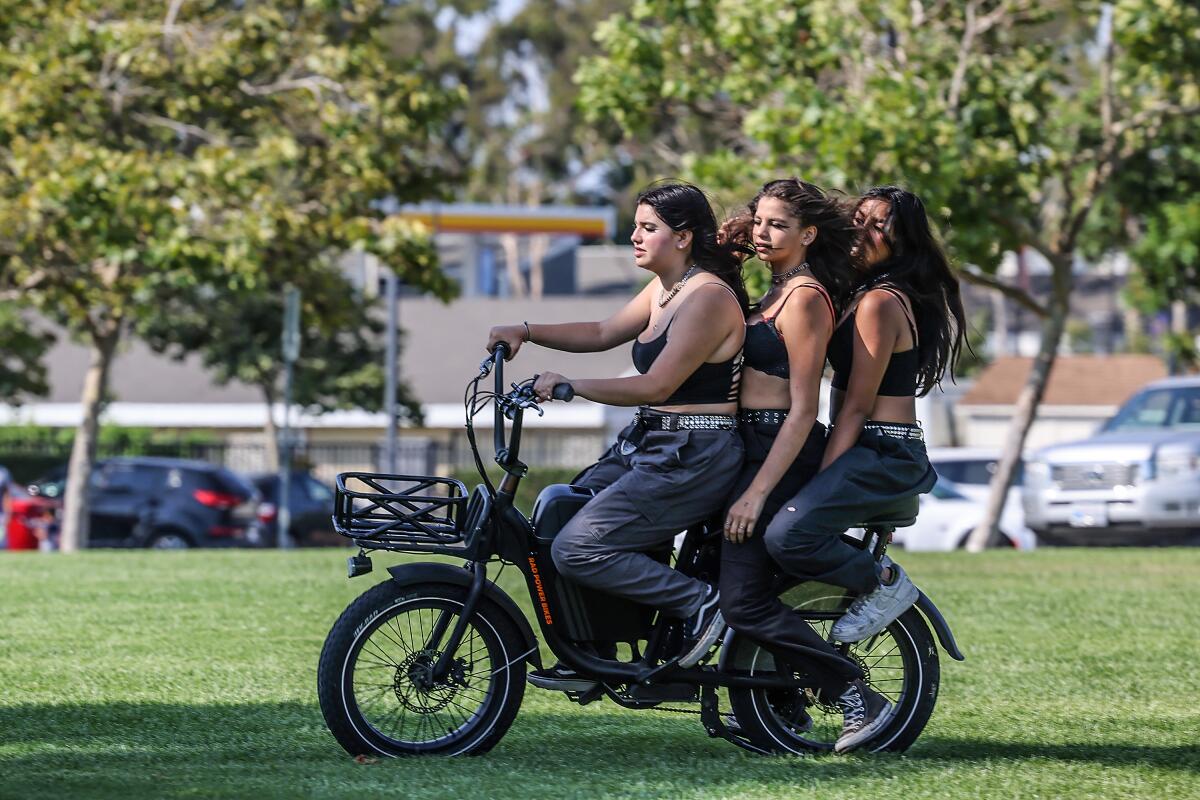
California and the rest of the United States are playing catch up with an electrified mode of transit that is firmly cemented in Asia and Europe: the e-bike.
But as battery-powered bicycles grow in popularity here, safety concerns are growing too. Several Southern Californians have sued e-bike manufactures after crashes or malfunctions, including one in 2021 that resulted in the death of a 12-year-old Pacific Palisades girl.
“There has to be some awareness that this is not a toy,” said Aaron Wong, co-founder of Super73, an Irvine-based manufacturer of electric bikes.
What are e-bikes?
The term “e-bike” refers to two-wheeled electric-motor-assisted bicycles. E-bikes are produced with all the features of a regular bicycle with the addition of an electric motor that generates less than 750 watts, said Ronald Ongtoaboc, a public information officer at the Department of Motor Vehicles.
California law outlines three classes of e-bikes:
- Class 1: The motor assists the rider only when the rider pedals, and it stops assisting at 20 mph.
- Class 2: The motor can propel the bicycle without the rider pedaling, up to 20 mph.
- Class 3: The motor assists the rider only when the rider is pedaling and stops assisting when the bike reaches 28 mph.
An e-bike allows riders of any skill or fitness level to reach significant speeds. For reference, Tour de France riders average 25 to 28 mph on flat terrain.
If you haven’t seen an e-bike on the road yet, you probably will soon. Revenue grew 47% in the 12 months ending in October 2021, compared with the same period a year earlier, according to an analysis by NPD Group.
That’s due in part to changing attitudes in the U.S. about the role of cycling, which has long focused on sport, fitness and recreation, said Edward Benjamin, chairman of the Light Electric Vehicle Assn. But, Benjamin added, more American riders are starting to regard cycling the way people in Europe and Asia do: as a primary mode of transportation.
Super73’s Wong says that tracks with what he hears from his customers, who report using e-bikes to commute to work or school several times a week.
He along with other electric bike enthusiasts and health agencies are now leading the conversation in ride safety.
After a girl died in the Pacific Palisades after falling from an electric bike, her parents are suing
Riding an e-bike is different
One of the biggest mistakes a new e-bike rider can make is treating it like a conventional bicycle, said Helen Arbogast, injury prevention manager at Children’s Hospital Los Angeles.
There are two stark differences. To start, e-bikes are much heavier. Arbogast said the bikes can be anywhere from 15 to 25 pounds heavier because of the motor, battery and frame. Especially if a minor is operating an e-bike, she said, you’ll want to consider their ability to manage the bike’s weight when they’re steering it or in the event they should fall. The second difference, Arbogast said, is how the motor assists the rider and how much assistance it gives. New riders should take the time to understand the product, whether it’s age appropriate, where it can be ridden legally, and whether it will meet your needs.
“We encourage as many people as we can to actually touch and feel the bikes, swing a leg over it before you even power it on so you understand where the controls and brakes are,” Wong said.
Once you’ve selected your bike, Wong and Arbogast said, practice riding it. Don’t assume you know how to control an e-bike because you know how to ride a bicycle.
Some of the rules of the road are different too. You can ride a Class 1 or Class 2 e-bike on any paved surface where you would ride a regular bike. But riders of Class 3 e-bikes must be 16 or older and wear a helmet. Local rules will also determine whether a Class 3 is allowed in certain bike lanes.
Activists want to push the city to carve out more street space for cyclists and pedestrians. But many drivers fear more congestion with loss of lanes.
A proper helmet
Arbogast said another measure an e-bike rider can take is protecting their brain, head and face from serious injury by wearing a helmet.
“If we treated our brain like the computers of our body, we would make sure it was protected,” Arbogast said.
“I know very few people who walk around with their smartphones without a case on them.”
Californians 17 and under are required to wear helmets on bicycles by law.
The type of helmet you wear on these bikes is at your discretion, but Arbogast said riders of all ages should consider the fact that regular bike helmets are crash tested at 14 mph — e-bikes go faster than that. She recommends that e-bike riders, especially those under 17, wear a U.S. Department of Transportation complaint motorcycle safety helmet when riding a motorized bicycle.
Once you have a helmet, make sure it fits properly and that you wear it correctly.
“Putting a helmet on your head without properly strapping it in is just making a decision to wear a horrible hat,” Arbogast said.
Children’s Hospital Los Angeles shared several tips on ensuring your helmet fits properly.
- Snug: Helmets should not move around on your head once fastened.
- Level: There should be room for only one or two finger widths above the eyebrows.
- Secure: The left and right side straps should form a “y” and meet right below the ear. Only one finger should fit under the strap.
A helmet is just one way to ensure you’re protected. You’ll also want to keep up with the maintenance of your e-bike. For example, check the tire pressure and regularly test your brakes.
Kevin Claxton, operations manager for the California Bicycle Coalition, said safety also comes in numbers.
“At the California Bicycle Coalition, we think it’s fantastic that more people are getting on bikes of all kinds. The more people who are out riding bikes, the safer our streets become for people on bikes,” Claxton said.
What helmets can’t do is prevent cars from crashing into people, Claxton said. His organization believes more infrastructure for riders — protected bike lanes and intersections, as well as connected networks of lanes — is part of a safer cycling experience.
If you’ve been thinking about going car-free in L.A. or even just driving less, these riders’ stories can help you get started.
Riding etiquette
Start with the basics — learn the hand signals used to alert drivers and fellow cyclists to your actions.
Be aware of other riders and drivers on the road, and no salmoning — always ride on the right-hand side with traffic, never against it.
For younger riders, consider that e-bikes can travel faster, so decision making and reaction time have to be quicker. Arbogast said parents have to decide whether their child is mature enough and has enough riding experience for an e-bike.
Also be aware of your surroundings. That could mean buying accessories. For example, Arbogast said a Class 1 e-bike can be ridden on the sidewalk (in some cities), which means the rider is going to have to share that space with pedestrians. In this scenario, you’ll want a bell or horn to let people know you are approaching from behind. If you’re riding after dark, you’ll want lights and reflective clothing to ensure you can be seen by drivers and pedestrians.
And limit distractions. Don’t use your phone while riding. If you want to listen to music, use a speaker. If you have earbuds or headphones on, you could miss someone honking their horn to get your attention or other important sounds.
L.A. has seen residential streets become speedways. People are frightened, and tired of waiting for fixes.
Talk with an expert
To meet the e-bike demand, there are inexpensive e-bikes consumers can buy online and have delivered to their home, said Mike Stefanos, manager at the bike shop Velo Pasadena.
“Unfortunately, they’re often unreliable and they eventually become disposable because there is no support from that manufacturer and the motors are much lower quality,” Stefanos said.
In 2022, people are also more likely to buy a product online versus going to the store, Arbogast added. Websites have the specifics about their products but might not have safety tips, recommended safety gear or guidance on sharing the road.
She said injury prevention organizations and agencies need to do so and are starting to work on more safety resources, such as informational videos, but there currently is a gap in information.
Before you hit “add to cart,” consider visiting your local bike shop to learn more about e-bikes.
Stefanos said the Velo Pasadena team will ask customers what their main purpose is for the product and go from there.
“For example, if someone says they have little bike experience and live in a very hilly area, then we can explain how different motor styles and torque specs can benefit them,” he said.
If the Velo customer is a minor with their parent, they’re typically going to use the bike for commuting to school. Stefanos said he’ll ask the customers how bike security is at the campus so he can warn them about bike theft.
“We recommend they get a Class 1 bike and we explain how the e-bikes we sell are getting more and more e-bike-rated components, such as stronger brakes, for safety,” he said.
Regardless of bicycle style or rider age, the team always recommends the right helmet and lights to all customers.
As long as there’s adequate safety training like anything else, Arbogast said, e-bikes are a great option for transportation, getting outdoors and getting kids and adults active.
About The Times Utility Journalism Team
This article is from The Times’ Utility Journalism Team. Our mission is to be essential to the lives of Southern Californians by publishing information that solves problems, answers questions and helps with decision making. We serve audiences in and around Los Angeles — including current Times subscribers and diverse communities that haven’t historically had their needs met by our coverage.
How can we be useful to you and your community? Email utility (at) latimes.com or one of our journalists: Jon Healey, Ada Tseng, Jessica Roy and Karen Garcia.
More to Read
Sign up for Essential California
The most important California stories and recommendations in your inbox every morning.
You may occasionally receive promotional content from the Los Angeles Times.

